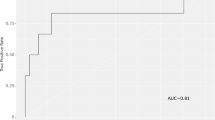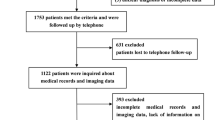Abstract
Purpose
Several methods have been developed to prevent lateral hinge fractures (LHFs), using only classic statistical models. Machine learning is under the spotlight because of its ability to analyze various weights and model nonlinear relationships. The purpose of this study was to create a machine learning model that predicts LHF with high predictive performance.
Methods
Data were collected from a total of 439 knees with medial osteoarthritis (OA) treated with Medial open wedge high tibial osteotomy (MOW-HTO) from March 2014 to February 2020. The patient data included age, sex, height, and weight. Preoperative, determined, and modifiable factors were categorized using X-ray and CT data to create ensemble models with better predictive performance. Among the 57 ensemble models, which is the total number of possible combinations with six models, the model with the highest area under curve (AUC) or F1-score was selected as the final ensemble model. Gain feature importance analysis and the Shapley additive explanations (SHAP) feature explanation were performed on the best models.
Results
The ensemble model with the highest AUC was a combination of a light gradient boosting machine (LGBM) and multilayer perceptron (MLP) (AUC = 0.992). The ensemble model with the highest F1-score was the model that combined logistic regression (LR) and MLP (F1-score = 0.765). Distance X was the most predictive feature in the results of both model interpretation analyses.
Conclusion
Two types of ensemble models, LGBM with MLP and LR with MLP, were developed as machine learning models to predict LHF with high predictive performance. Using these models, surgeons can identify important features to prevent LHF and establish strategies by adjusting modifiable factors.
Study design
Retrospective cohort study.
Level of evidence
3.





Similar content being viewed by others
References
Choi HG, Kim JS, Jung YS, Yoo HJ, Lee YS (2021) Prediction and development of preventive strategies for lateral hinge fracture during opening wedge high tibial osteotomy based on osteotomy configurations. Am J Sports Med 49:2942–2954
Francois C (2017) Deep learning with Python. Manning Publications Company, New York
Groot OQ, Bindels BJJ, Ogink PT, Kapoor ND, Twining PK, Collins AK et al (2021) Availability and reporting quality of external validations of machine-learning prediction models with orthopedic surgical outcomes: a systematic review. Acta Orthop 92:385–393
Han S-B, Choi J-H, Mahajan A, Shin Y-S (2019) Incidence and predictors of lateral hinge fractures following medial opening-wedge high tibial osteotomy using locking plate system: better performance of computed Tomography scans. J Arthroplasty 34:846–851
Han SB, Lee DH, Shetty GM, Chae DJ, Song JG, Nha KW (2013) A “safe zone” in medial open-wedge high tibia osteotomy to prevent lateral cortex fracture. Knee Surg Sports Traumatol Arthrosc 21:90–95
Harris AH, Kuo AC, Bowe TR, Manfredi L, Lalani NF, Giori NJ (2021) Can machine learning methods produce accurate and easy-to-use preoperative prediction models of one-year improvements in pain and functioning after knee arthroplasty? J Arthroplasty 36(112–117):e116
Hong N, Park H, Kim CO, Kim HC, Choi JY, Kim H et al (2021) Bone radiomics score derived from DXA hip images enhances hip fracture prediction in older women. J Bone Miner Res 36:1708–1716
Jeni LA, Cohn JF, De La Torre F (2013) Facing imbalanced data--recommendations for the use of performance metrics. Paper presented at: 2013 Humaine association conference on affective computing and intelligent interaction.
Kim TW, Lee SH, Lee JY, Lee YS (2019) Effect of fibular height and lateral tibial condylar geometry on lateral cortical hinge fracture in open wedge high tibial osteotomy. Arthroscopy 35:1713–1720
Lee OS, Lee YS (2018) Diagnostic value of computed tomography and risk factors for lateral hinge fracture in the open wedge high tibial osteotomy. Arthroscopy 34:1032–1043
Lee SJ, Kim JH, Baek E, Ryu HS, Han D, Choi W (2021) Incidence and factors affecting the occurrence of lateral hinge fracture after medial opening-wedge high tibial osteotomy. Orthop J Sports Med 9:23259671211035372
Lee SS, Celik H, Lee DH (2018) Predictive factors for and detection of lateral hinge fractures following open wedge high tibial osteotomy: plain radiography versus computed tomography. Arthroscopy 34:3073–3079
Lundberg SM, Erion GG, Lee S-I (2018) Consistent individualized feature attribution for tree ensembles. arXiv preprint arXiv:1802.03888
Lundberg SM, Lee S-I (2017) A unified approach to interpreting model predictions. Advances in neural information processing systems 30, NIPS 2017, Long Beach, CA, USA
Meidinger G, Imhoff AB, Paul J, Kirchhoff C, Sauerschnig M, Hinterwimmer S (2011) May smokers and overweight patients be treated with a medial open-wedge HTO? Risk factors for non-union. Knee Surg Sports Traumatol Arthrosc 19:333–339
Miller BS, Dorsey WO, Bryant CR, Austin JC (2005) The effect of lateral cortex disruption and repair on the stability of the medial opening wedge high tibial osteotomy. Am J Sports Med 33:1552–1557
Miller BS, Downie B, McDonough EB, Wojtys EM (2009) Complications after medial opening wedge high tibial osteotomy. Arthroscopy 25:639–646
Nakamura R, Komatsu N, Murao T, Okamoto Y, Nakamura S, Fujita K et al (2015) The validity of the classification for lateral hinge fractures in open wedge high tibial osteotomy. Bone Joint J 97-B:1226–1231
Ramkumar PN, Karnuta JM, Haeberle HS, Owusu-Akyaw KA, Warner TS, Rodeo SA et al (2021) Association between preoperative mental health and clinically meaningful outcomes after osteochondral allograft for cartilage defects of the knee: a machine learning analysis. Am J Sports Med 49:948–957
Ray S. A quick review of machine learning algorithms (2019) Paper presented at: 2019 International conference on machine learning, big data, cloud and parallel computing (COMITCon).
Rose T, Imhoff AB (2007) Complications after transgenicular osteotomies. Oper Tech Orthop 17:80–86
Samuel AL (1988) Some studies in machine learning using the game of checkers. II-recent progress. Computer Games I:366–400
Stoffel K, Stachowiak G, Kuster M (2004) Open wedge high tibial osteotomy: biomechanical investigation of the modified arthrex osteotomy plate (puddu plate) and the TomoFix plate. Clin Biomech 19:944–950
Vickers AJ, Holland F (2021) Decision curve analysis to evaluate the clinical benefit of prediction models. Spine J 21:1643–1648
Yacobucci GN, Cocking MR (2008) Union of medial opening-wedge high tibial osteotomy using a corticocancellous proximal tibial wedge allograft. Am J Sports Med 36:713–719
Yoo OS, Lee YS, Lee MC, Park JH, Kim JW, Sun DH (2016) Morphologic analysis of the proximal tibia after open wedge high tibial osteotomy for proper plate fitting. BMC Musculoskelet Disord 17:423
Youngstrom EA (2014) A primer on receiver operating characteristic analysis and diagnostic efficiency statistics for pediatric psychology: we are ready to ROC. J Pediatr Psychol 39:204–221
Zhang Y, Yang D, Liu Z, Chen C, Ge M, Li X et al (2021) An explainable supervised machine learning predictor of acute kidney injury after adult deceased donor liver transplantation. J Transl Med 19:321
Zhou Z-H (2012) Ensemble methods: foundations and algorithms. CRC Press, Boca Raton
Funding
This work was supported by the National Research Foundation of Korea (NRF) grant funded by the Korean Government (MSIT). No.2021R1A2C1092657.
Author information
Authors and Affiliations
Contributions
HWJ, HGC and YSL participated in study design and drafted the manuscript, HWJ and MJK performed the statistical analysis, HWJ, MJK and SYP collected the data and contributed to performing statistical analysis, SYP conceived of the study, participated in coordination and helped to draft the manuscript. All authors read and approved the final.
Corresponding author
Ethics declarations
Conflict of interest
The authors declare that they have no conflicts of interest.
Ethical approval
This article does not contain any studies with human participants or animals performed by any of the authors.
Additional information
Publisher's Note
Springer Nature remains neutral with regard to jurisdictional claims in published maps and institutional affiliations.
Rights and permissions
Springer Nature or its licensor holds exclusive rights to this article under a publishing agreement with the author(s) or other rightsholder(s); author self-archiving of the accepted manuscript version of this article is solely governed by the terms of such publishing agreement and applicable law.
About this article
Cite this article
Jeong, H.W., Kim, M., Choi, H.G. et al. Development of a machine learning model to predict lateral hinge fractures by analyzing patient factors before open wedge high tibial osteotomy. Knee Surg Sports Traumatol Arthrosc 31, 3070–3078 (2023). https://doi.org/10.1007/s00167-022-07137-6
Received:
Accepted:
Published:
Issue Date:
DOI: https://doi.org/10.1007/s00167-022-07137-6




